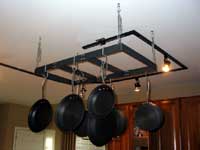| |
|
click for a larger image |
Here's a map of the kitchen that I used for the track lighting and the pot rack. |
|
 |
|
| I used toggle bolts to secure the rack to the ceiling dry wall.
|
|
 |
|
Here's the installed rack.
|
|
 |
|
| I built this template to do my slot routing so I could get them just the right width to accomodate another board. |
|
 |
|
| It's easier to do multiple small cuts than one big cut so I routed out only half the board first. |
|
 |
|
| Then I routed out the rest. |
|
 |
|
| Here's what the whole piece looked light after the routing. |
|
 |
|
|
And here are all the routed pieces. |
|
 |
|
| A test fitment before putting on a decorative edge, sanding and staining. |
|
 |
|
| After putting on a roundover edge. |
|
 |
|
| Roundover edge from another angle. Note all the burn marks from stopping the router. |
|
 |
|
| You can feel like you did a lot when you have a big pile of sawdust. This is only one of two piles I had. |
|
 |
|
| After sanding, I stained all the pieces Pecan (b/c I like pecans) using MinWax PolyShades (stain and polyurethane in one step). |
|
 |
|
After the first coat of polyurethane stain, rub smooth the stained wood with fine grade 000 steel wool or a green ScotchBrite pad.
ScotchBrite pads are convenient, they'll fit your sander and don't get mangled up as much. |
|
 |
|
| After any sanding or smoothing, wipe off any dust with a damp (not wet) towel. |
|
 |
|
| Here's an example of what the wood looks like after two coats of stain, one coat and bare wood. Note that the two coat stain isn't completely dry and will darken a little more. |
|
 |
|
| Once everything was dry, I assembled the shelf, making sure the shelves are square (straight horizontally and vertically). I then screwed on the backing board, countersinking all the holes for a flat finish. The backing board was made of two 2'x4' 1/4" MDF panels. They were not trimmed or cut before attaching, they will be routed flush in the next step. |
|
 |
|
| I used painter's tape to line the edges where the flush trimming will occur. A flush trim bit works by using a bearing that is the same diameter as the cutting edge so you can run it along an outline to trim off excess. Running tape will help protect the finish from any possible scratching or marking from the bearing. |
|
 |
|
Here's a picture of running the flush trim bit down the back board, following the taped edge.
Note that anytime you cut MDF, you will generate an aweful lot of very fine saw dust. |
|
 |
|
| Here's a comparison of my old book shelf that I was using for DVDs. It was much smaller and only had 3 levels that didn't really fit well. My DVDs were starting to over-flow the shelf's capacity. |
|
 |
|
| The new shelf has five levels for DVDs, plus end areas and a top for displaying knick-knacks and other items. Additionally the edges are cut at a 45 degree angle to match the countours of my walls. |
|
 |
|
| Here is the shelf in use, complete with DVDs, knick-knacks and miscellaneous items. Looks like I have plenty of expansion room now. |
|
 |
|

